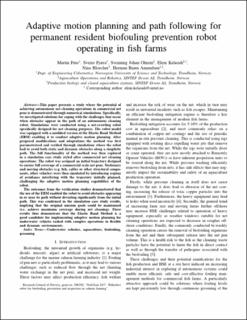| dc.contributor.author | Føre, Martin | |
| dc.contributor.author | Fjæra, Sverre | |
| dc.contributor.author | Ohrem, Sveinung Johan | |
| dc.contributor.author | Kelasidi, Eleni | |
| dc.contributor.author | Bloecher, Nina | |
| dc.contributor.author | Amundsen, Herman Biørn | |
| dc.date.accessioned | 2024-02-01T08:23:02Z | |
| dc.date.available | 2024-02-01T08:23:02Z | |
| dc.date.created | 2022-04-04T10:32:31Z | |
| dc.date.issued | 2022 | |
| dc.identifier.issn | 0197-7385 | |
| dc.identifier.uri | https://hdl.handle.net/11250/3114975 | |
| dc.description.abstract | This paper presents a study where the potential of achieving autonomous net cleaning operations in commercial net pens is demonstrated through numerical simulations. Specifically, we investigated solutions for coping with the challenges that occur when obstacles appear in the path of an autonomous cleaning robot. Simulations were conducted using a net-crawling robot specifically designed for net cleaning purposes. The robot model was equipped with a modified version of the Elastic Band Method (EBM) enabling it to conduct adaptive motion planning. After proposed modifications and adaptations the method was first parameterised and verified through simulations where the robot had to avoid both static and dynamic obstacles along a simplistic path. The full functionality of the method was then explored in a simulation case study styled after commercial net cleaning operations: The robot was assigned an initial trajectory designed to ensure full coverage of a commercial scale net pens. Stationary and moving obstacles (e.g. fish, cables or other structural components, other vehicles) were then simulated by introducing regions of avoidance interfering with the trajectory initially planned, challenging the adaptive motion planning capabilities of the robot. The outcomes from the verification studies demonstrated that the use of the EBM enabled the robot to avoid obstacles appearing in or near its path without deviating significantly from the initial path. This was confirmed in the simulation case study results, implying that the original mission goals could be maintained (i.e. achieve maximum coverage during net cleaning). These results thus demonstrate that the Elastic Band Method is a good candidate for implementing adaptive motion planning for underwater vehicles tasked with complex operations in flexible and dynamic environments. | en_US |
| dc.language.iso | eng | en_US |
| dc.publisher | IEEE | en_US |
| dc.title | Adaptive motion planning and path following for permanent resident biofouling prevention robot operating in fish farms | en_US |
| dc.title.alternative | Adaptive motion planning and path following for permanent resident biofouling prevention robot operating in fish farms | en_US |
| dc.type | Journal article | en_US |
| dc.description.version | acceptedVersion | en_US |
| dc.rights.holder | © Copyright 2021 IEEE - All rights reserved. | en_US |
| dc.source.journal | OCEANS | en_US |
| dc.identifier.doi | 10.23919/OCEANS44145.2021.9706041 | |
| dc.identifier.cristin | 2015034 | |
| dc.relation.project | Norges forskningsråd: 296392 | en_US |
| cristin.ispublished | true | |
| cristin.fulltext | postprint | |
| cristin.qualitycode | 0 | |
